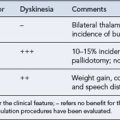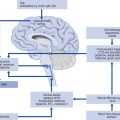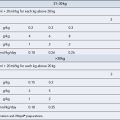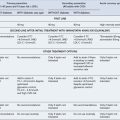29 Affective disorders
Aetiology
Physical illness and side effects of medication
Disorders of mood, particularly depression, have been associated with several types of medication and a number of physical illnesses (Box 29.1). Depression can affect the outcome in people with a range of physical problems. An increase in death rates has been found in those patients with co-morbid depression.
Clinical manifestations
Bipolar disorder
Standardised diagnostic criteria vary. For an ICD 10 diagnosis of bipolar disorder, at least two mood episodes must occur, one of which must be manic or hypomanic (Box 29.2). According to DSM IV, at least one episode of mania must have occurred for a diagnosis of bipolar I disorder to be made; depression may also occur, but it is not essential.
Severity
The severity of the disorder may vary from mild through moderate to severe. In most circumstances, it would be inappropriate for people with mild forms of the disorders to be seen by specialist services and treated with pharmacotherapy. In the absence of a risk of serious self-harm, people with less severe forms of the disorder should be treated by the primary health care team. Guidelines advise that a stepwise approach is taken on the management of depression, with increasing evidence supporting the fact that antidepressant therapy is more likely to be effective in the more severe episodes (NICE, 2009).
If left untreated, it is important to remember that affective disorders carry a risk of mortality. In addition to suicidal attempts by someone who is depressed, the lack of self-care and physical exhaustion resulting from mania may be life-threatening. The social and financial consequences can have a devastating effect on both the patient with mania or hypomania and their family. Depression may also contribute to exacerbation of physical problems such as increased pain and worsening outcomes from cardiac disease (Nicholson et al., 2006).
Investigations
In the UK, mental and behavioural disorders are commonly classified using the International Classification of Diseases, ICD 10 (WHO, 1992).The American Psychiatric Association has developed a precise system of diagnosis, based on the description of symptoms in the Diagnostic and Statistical Manual of Mental Disorders (DSM IV TR), now in its revised, fourth edition (American Psychiatric Association, 2000).
A systematic approach to the diagnosis of affective disorders is important when considering the effectiveness of medication. Most new clinical trials for antidepressants or antipsychotics require a DSM diagnosis as an entry criterion. In the UK, the ICD 10 classification is commonly used, with the severity of depression determined by the presence of the number of symptoms (see Boxes 29.2 and 29.3). More recently, use of the symptom count as a single factor upon which to base treatment decisions has been cautioned against (NICE, 2009). Account should also be taken of the extent of impairment and disability associated with depression.
Box 29.3 ICD 10 diagnostic criteria for a depressive episode (WHO, 1992)
Common symptoms
National guidelines provide a sound framework for the management of depression (NICE, 2009) and bipolar disorder (NICE, 2006). It is important that people with depression are identified. A simple screening process for the presence of depression could involve asking the patient two questions about their mood and interest. For example, the patient could be asked ‘During the last month, have you often been bothered by feeling down, depressed or hopeless?’ and ‘During the last month, have you often been bothered by having little interest or pleasure in doing things?’. If the answer to either question is ‘no’, it is unlikely the patient will be considered to have a depressive disorder. Patients who answer ‘yes’ warrant further investigation.
Treatment
In the treatment of depression, all the antidepressants currently available in the UK may be considered to be equally effective. There is increasing evidence that patients with more severe episodes of depression are more likely to respond to antidepressant drugs, as opposed to placebo, than those with less severe forms of the disorder (Fournier et al., 2010). There is also some evidence to suggest that sertraline and escitalopram may have a more favourably risk/benefit profile than some other antidepressants (Cipriani et al., 2009). However, it is unclear if the magnitude of the difference between these drugs is sufficient to direct treatment choice for most depressed patients.
Treatment of depression
Drug treatment
Generally speaking, the older drugs have a poorer side effect (Barbui et al., 2001; Geddes et al., 2002) and toxicity profile than the more recently introduced agents. Traditionally, the antidepressant drugs are categorised by their chemical structure, for example, tricyclic, or their predominant pharmacological action, for example, MAOI, SSRI.
Tricyclic antidepressants
Clomipramine
Data from a fatal toxicity index (Buckley and McManus, 2002) show clomipramine to have a lower than expected toxicity index. It is unlikely that clomipramine is inherently less toxic than other antidepressants, so this finding could be accounted for by other factors, such as the relatively high rate of prescribing in non-depressive states.
Dosulepin
Guidelines for the management of depression (NICE, 2009) advise that dosulepin should not be prescribed because of the risks associated with cardiac problems and toxicity in overdose compared to other available treatments.
Selective serotonin reuptake inhibitors
These agents were developed in an attempt to reduce some of the problems associated with the tricyclic antidepressants. Overall, the SSRIs are better tolerated by most patients and coupled with the fact that they are considerably less toxic in overdose; this means that they should be the first-line choice for the pharmacological management of moderate or severe depression (NICE, 2009). As generic versions of the drugs are available, the financial impact of using SSRIs first line has reduced in recent years. The SSRIs have a broadly similar range of side effects, but there are variations in the intensity or duration. The degree of specificity for serotonin reuptake differs between the SSRIs, but this does not correlate with clinical efficacy. If given in adequate doses for an adequate period of time, all the drugs in this class appear to be equally effective.
Other drugs
Venlafaxine
Venlafaxine was reported to be the first in a new class of antidepressants, the serotonin-noradrenaline reuptake inhibitors (SNRIs). These antidepressants were developed in an attempt to improve efficacy over the standard agents. As the name suggests, they prevent the reuptake of both serotonin and noradrenaline (norepinephrine), a mechanism they have in common with the tricyclic antidepressants. It was hoped this would result in a drug with similar efficacy to the tricyclics in more severe cases but without the antimuscarinic, cardiac or toxic effects of the older drugs. Guidelines for depression (NICE, 2009) highlight the relative poor tolerability and increased risks of toxicity compared to the SSRIs. In view of this, venlafaxine is not recommended as a first-line treatment for patients with moderate or severe depression.
Agomelatine
Agomelatine is structurally related to melatonin, it gained regulatory approval for use as an antidepressant in Europe in 2009. It is thought to act as an agonist at melatonin MT1 and MT2 and antagonist at 5HT2c (Kasper and Hamon, 2009). In contrast to other antidepressants, it has no effect on monoamine uptake systems. Liver function tests are required prior to commencement and at intervals during treatment as rare cases of hepatic dysfunction have been reported. As yet there is insufficient evidence to comment on the place of this drug in the management of depression, but its relatively high cost may limit its use within the UK.
Choice of antidepressant
Whilst it has been suggested (Cipriani et al., 2009) that sertraline and escitalopram should be considered first-choice antidepressants for the majority of patients, it is unclear whether this will be translated into routine practice. The severity of the disorder, patient preference and previous experience should also play a part as they are also likely to affect outcome. In some areas, cost has become a critical factor in choice. For most people with moderate-to-severe depression, unless otherwise contraindicated, the use of a generic SSRI as the first-line choice is appropriate. Previous response, tolerance and the likelihood of drug interactions should also be considered.
Other treatments
Non-drug treatments
In addition to drug treatment, it is important to consider the patient’s wider social, cultural and environmental circumstances. Although most patients with moderate to severe symptoms of depression will be offered pharmacological treatment, all patients and their close family should be offered help and support to cope with depression. Specific non-pharmacological interventions such as cognitive behaviour therapy (CBT) can be as effective as drug treatments. For people with more severe symptoms of depression, a combination of antidepressants and CBT is recommended. For mild-to-moderate forms of depression or persistent sub-threshold symptoms, then non-drug strategies based on the principals of CBT should be considered as the first-line treatment (NICE, 2009).
St John’s wort (Hypericum perforatum)
Extracts of hypericum have been shown to be as effective as standard antidepressants in the management of major depression (Linde et al., 2008). In England and Wales, prescribers are advised against prescribing hypericum because of uncertainty about appropriate doses and persistence of effect. Problems can also be caused due to the variation in the nature of preparations available and the potential for serious interactions with other drugs.
Treatment of mania
When used prophylactically the antimanic agents are commonly referred to as mood stabilisers.
Lithium
Following an acute episode, lithium is a well-established treatment that may be considered as a first-line option for prophylaxis (Baldessarini and Tondo, 2000). Continuation therapy with a prophylactic mood stabiliser should be considered in all bipolar patients who have had two or more acute episodes within 2–4 years. It may also be reasonable to consider prophylaxis in any patient following a severe manic episode. As treatment is long term, the cooperation of the patient is essential and so a thorough explanation of the risks and benefits of the treatment is vital.
Other anticonvulsants
Carbamazepine is generally considered as a second-line prophylactic treatment, when first-line therapy is either not tolerated or is ineffective. Emerging evidence continues to support the use of lamotrigine as an alternative in patients with bipolar depression (Geddes et al., 2009).
Patient care
Patients should always be offered the opportunity of discussing their medication. The use of patient information leaflets and the involvement of the family or close friends may help patients understand the risks and benefits of their treatment. Many of the drugs used in the treatment of affective disorders have the potential to interact with other drugs that have been prescribed or purchased. Some of these are summarised in Table 29.1.
Table 29.1 Examples of important drug interactions with drugs used in the management of affective disorders
| Antidepressant | Interacting drug | Effect |
|---|---|---|
| Tricyclics | Adrenaline (epinephrine) and other directly acting sympathomimetics | Greatly enhances effect. Dangerous acting sympathomimetics |
| Alcohol | Enhanced sedation | |
| Antiarrhythmics | Risk of ventricular arrhythmias | |
| Anticonvulsants | Lowered seizure threshold and possible lowered tricyclic levels | |
| MAOIs | Severe hypertension | |
| Fluoxetine | Increased tricyclic serum levels | |
| SSRIs | Anticoagulants | Enhanced effects |
| MAOIs | Dangerous | |
| Lithium | Possible serotonin syndrome | |
| MAOIs | Alcohol, fermented beverages, tyramine-rich foods | Hypertensive crisis |
| Antihypertensives | Increased effect | |
| Anticonvulsants | Lowered seizure threshold | |
| Levodopa | Hypertensive crisis | |
| Sympathomimetics | Hypertensive crisis | |
| Antipsychotics | Anaesthetic agents | Hypotension |
| Anticonvulsants | Lowered seizure threshold | |
| Antiarrhythmics | Risk of ventricular arrhythmias | |
| Astemizole and terfenadine | Risk of ventricular arrhythmias | |
| Lithium | Non-steroidal anti-inflammatory drugs (NSAIDs) | Possible serotonin syndrome |
| SSRIs | Possible serotonin syndrome | |
| Diuretics | Enhanced lithium serum levels particularly with thiazides | |
| Angiotensin-converting enzyme (ACE) inhibitors | Enhanced lithium serum levels | |
| Sumatriptan | Possible central nervous system toxicity | |
| St John’s wort | Induces cytochrome P450 enzymes, particularly | |
| 1A2, 2C9 and 3A4 | ||
| Indinavir | Reduced serum concentration (avoid) | |
| Warfarin | Reduced anticoagulant effect (avoid) | |
| SSRIs | Increased serotonergic effect (avoid) | |
| Carbamazepine (and other anticonvulsants) | Reduced serum concentrations (avoid) | |
| Digoxin | Reduced serum concentration (avoid) | |
| Oestrogens and progestogens | Reduced contraceptive effect (avoid) | |
| Theophylline | Reduced serum concentration (avoid) | |
| Ciclosporin | Reduced serum concentration (avoid) |
Common therapeutic problems in the management of affective disorder are outlined in Table 29.2.
Table 29.2 Common therapeutic problems in the management of affective disorder
| Problem | Possible solution |
|---|---|
| Antidepressants | |
| Treatment failure (30–40% of patients will not respond to first antidepressant) | Ensure adequate dose and duration of treatment |
| Check adherence, engage the patient, develop therapeutic alliance | |
| Reassess response against target symptoms | |
| Risk of self-harm | Reconfirm diagnosis and identify compounding factors, for example, high levels of alcohol consumption in unsupervised situations |
| Withdrawal reactions | Ensure gradual withdrawal |
| Relapse on discontinuation | Consider long-term treatment |
| Intolerance | Consider changing to a different class |
| Antimanic agents | |
| Treatment failure | Ensure adequate dose, check serum levels and adherence; consider drug combinations |
| Toxicity adverse effects | Determine dose by clinical response, guided by serum levels |
| Ensure patient is well informed and able to recognise impending toxicity and adverse effects of treatment | |
| Weight gain | Dietary advice; consider alternative pharmacotherapy |
| Lithium levels | Ensure serum levels are 12 h post-dose, taken in the morning. Regular monitoring is important |
Case 29.5
Whilst on the ward she attempted to develop sexual relationships with several young male patients.
Answer
In view of the obvious risk of fatality, alternative antidepressant treatment should be considered. Dosulepin could remain as an option for Ms AB due to her previous response to this drug and the lack of response to other antidepressants, but this would fall outside current guidance for the management of depression (NICE, 2009). Practical measures of controlling the quantities of medication should be introduced such as ensuring she only receives sufficient medication for 2 or 3 days treatment.
American Psychiatric Association. Diagnostic and Statistical Manual of Mental Disorders, fourth ed. Washington, DC: American Psychiatric Publishing Inc.; 2000. Text Revision (DSM-IV-TR)
Baldessarini R.J., Tondo L. Does lithium treatment still work? Evidence of stable responses over three decades. Arch. Gen. Psychiatry. 2000;57:187-908.
Barbui C., Hotopf M., Freemantle N., et al. Selective serotonin re-uptake inhibitors versus tricyclic and heterocyclic antidepressants: comparison of drug adherence. Cochrane Review. 2001. Cochrane Library, Issue 2. Update Software, Oxford
Buckley N.A., McManus P.R. Fatal toxicity of serotoninergic and other antidepressant drugs: analysis of United Kingdom mortality data. Br. Med. J.. 2002;325:1332-1333.
Cipriani A., Furukawa T.A., Salanti G., et al. Comparative efficacy and acceptability of 12 new-generation antidepressants: a multiple-treatments meta-analysis. Lancet. 2009;373:746-758.
Fournier J., DeRubeis R.J., Hollon S., et al. Antidepressant drug effects and depression severity A patient-level meta-analysis. J. Am. Med. Assoc.. 2010;303:47-53.
Geddes J.R., Freemantle N., Mason J., et al. Selective serotonin reuptake inhibitors (SSRIs) for depression. Cochrane Review. 2002. Cochrane Library, Issue 1. Update Software, Oxford
Geddes J.R., Calabrese J.R., Goodwin G.M. Lamotrigine for treatment of bipolar depression: independent meta-analysis and meta-regression of individual patient data from five randomised trials. Br. J. Psychiatry. 2009;194:4-9.
Kasper S., Hamon M. Beyond the monoaminergic hypothesis: agomelatine, a new antidepressant with an innovative mechanism of action. World J. Biol. Psychiatry. 2009;10:117-126.
Linde K., Berner M.M., Kriston L. St John’s wort for major depression. Cochrane Database of Systematic Reviews.. 2008. Issue 4, Art No. CD000448. doi:10.1002/14651858.CD000448.pub3
National Institute for Clinical Excellence. Bipolar Disorder. The Management of Bipolar Disorder in Adults, Children and Adolescents in Primary and Secondary Care, Clinical Guideline 38. London: NICE. 2006. Available at: http://www.nice.org.uk/nicemedia/live/10990/30193/30193.pdf Accessed 13 April. 2011
National Institute for Clinical Excellence. Depression. The Treatment and Management of Depression in Adults (Partial Update of NICE Clinical Guideline 23 on in Primary and secondary Care), Clinical Guideline 90.. London: NICE. 2009. Available at: http://www.nice.org.uk/nicemedia/live/12329/45888/45888.pdf Accessed 13 April. 2011
Nicholson A., Kuper H., Hemingway H. Depression as an aetiologic and prognostic factor in coronary heart disease: a meta-analysis of 6362 events among 146 538 participants in 54 observational studies. Eur. Heart J.. 2006;27:2763-2774.
World Health Organization. International Classification of Diseases and Related Health Problems, 10th Revision. Geneva: World Health Organisation; 1992. (ICD 10)
Cipriani A., Santilli C., Furukawa T.A., et al. Escitalopram versus other antidepressive agents for depression. Cochrane Database of Systematic Reviews.. (Issue 2):2009. Art. No.: CD006532. doi:10.1002/14651858.CD006532.pub2
Geddes J.R., Burgess S., Hawton K., et al. Long term lithium therapy for bipolar disorder: systematic review and meta-analysis of randomized controlled trials. Am. J. Psychiatry. 2004;161:217-222.
Gelder M., Andreasen N., Lopez-Ibor J., et al. Oxford Textbook of Psychiatry, second ed. Oxford: Oxford University Press; 2009.
Goodwin G. Evidence-based guidelines for treating bipolar disorder: revised second edition–recommendations from the British Association for Psychopharmacology. J. Psychopharmacol.. 2009;23:346-388.
Mann J.J. The medical management of depression. N. Engl. J. Med.. 2005;353:1819-1834.
Scottish Intercollegiate Guidelines Network. Bipolar Affective Disorder. Edinburgh: SIGN; 2005. Available at www.sign.ac.uk/pdf/sign82.pdf Accessed 13 April. 2011
Shiloh R., Stryjer R., Weizman A., et al. Atlas of Psychiatric Pharmacotherapy, second ed. Abingdon: Informa Healthcare; 2006.
Walden J., Heinz G., editors. Bipolar Affective Disorders: Etiology and Treatment. Stuttgart: Thieme Publishing Group, 2004.







